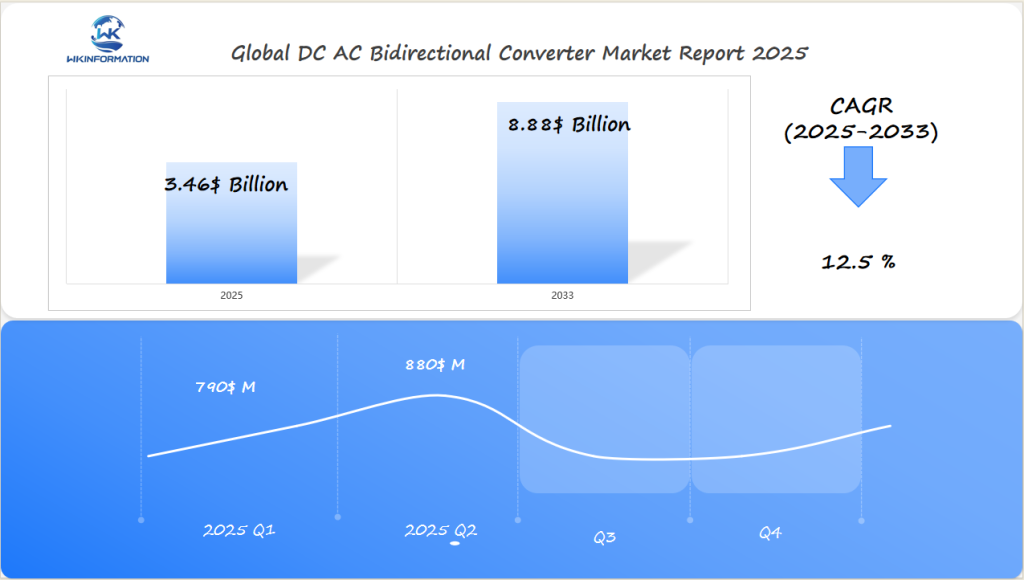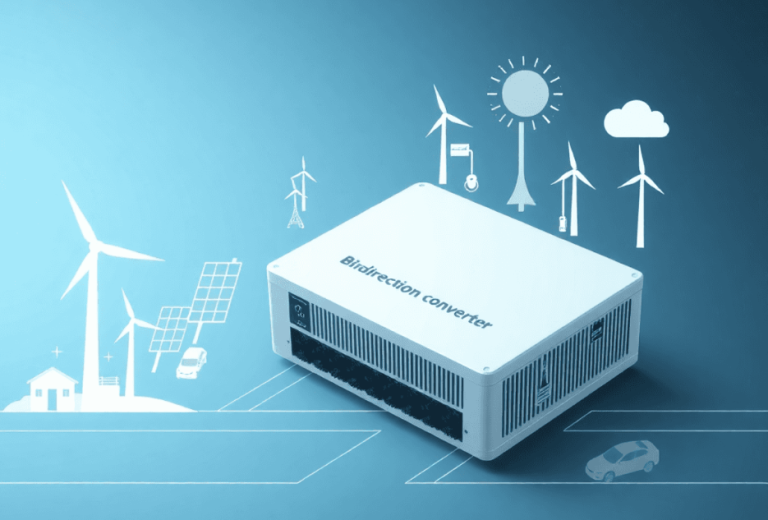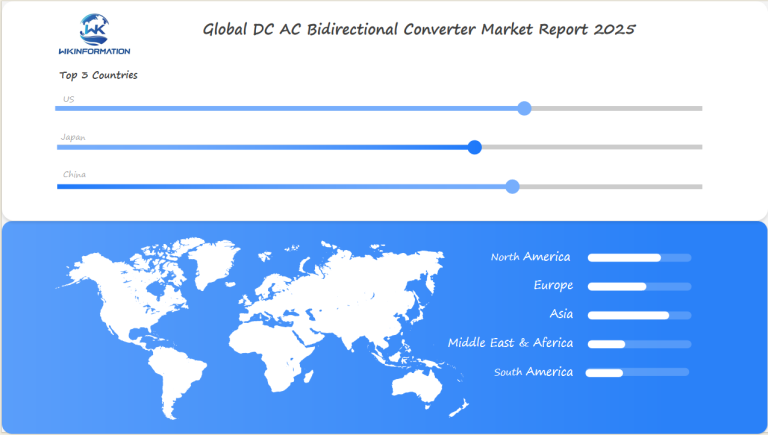2025 DC AC Bidirectional Converter Market Expansion Unlocking $3.46 Billion Potential in US, China, and Japan
Explore the expanding DC AC bidirectional converter market in the US, China, and Japan, examining how these regions navigate trade barriers while advancing sustainable energy solutions. Learn about converter technology, market drivers, and future industry trends in this comprehensive analysis of global power electronics innovation.
- Last Updated:
DC-AC Bidirectional Converter Market Forecast for Q1 and Q2 2025
The DC-AC bidirectional converter market is projected to be worth USD 3.46 billion in 2025, with a CAGR of 12.5% from 2025 to 2033. The market size is expected to reach approximately USD 790 million in Q1 2025 and increase to around USD 880 million in Q2 2025.
The US, China, and Japan are the dominant players in this market, driven by the rising adoption of energy storage systems, electric vehicles, and renewable energy integration. The US market is propelled by advancements in smart grid technology and growing investments in battery energy storage. China, being the largest EV producer, heavily relies on bidirectional converters for vehicle-to-grid (V2G) applications. Meanwhile, Japan’s leadership in power electronics and energy efficiency initiatives cements its position as a key market player.

Understanding the Supply Chain of DC AC Bidirectional Converters
The supply chain for DC AC bidirectional converters is complex, with multiple stages and players involved. Here’s a breakdown of how it works:
1. Raw Material Procurement
The process starts with sourcing raw materials like semiconductors and electronic components that are essential for making converters.
2. Manufacturing Phase
These raw materials are then used in the manufacturing phase, where important parts such as AC/DC converters and control systems are put together.
3. Key Industry Players
Several key players are involved in this industry, including:
- Component suppliers: Companies that provide the necessary parts and materials for manufacturing.
- Converter manufacturers: Businesses that specialize in producing DC AC bidirectional converters.
- System integrators: Organizations that combine different components and systems to create a complete solution.
Prominent companies like Siemens, ABB, and Schneider Electric have significant roles in this ecosystem by offering cutting-edge technology solutions and ensuring efficient energy conversion processes.
4. Importance of Precision in Manufacturing
Manufacturing processes require precision and depend heavily on technical expertise to uphold quality standards. Skilled professionals are essential for operating machinery, conducting inspections, and implementing quality control measures.
5. Role of Logistics
Logistics is a critical aspect of the supply chain, involving the transportation of finished products to various sectors such as EV manufacturers and renewable energy operators. Efficient logistics play a vital role in ensuring timely delivery, which in turn optimizes the integration of converters into larger energy storage systems.
By understanding these intricacies within the supply chain, stakeholders can identify opportunities for improvement and enhance overall efficiency in the production and distribution of DC AC bidirectional converters.
Key Trends Driving the DC AC Bidirectional Converter Market Growth in 2025
Influence of Renewable Energy on Demand for Converters
The integration of renewable energy sources has significantly impacted the demand for DC AC bidirectional converters. As solar and wind energy become increasingly incorporated into power grids, these converters are essential to manage fluctuations and ensure steady energy flow. Enhanced storage solutions offered by bidirectional converters allow for effective balancing of supply and demand.
Rise in Electric Vehicle Production and Its Impact on the Market
Electric vehicle (EV) production is on an upward trajectory, fueling growth in the converter market. Bidirectional converters play a critical role in optimizing battery charging and discharging processes, crucial for efficient EV operation. The surge in EV adoption necessitates advanced energy management systems, driving demand for cutting-edge converter technology.
Government Policies Promoting Sustainable Energy Solutions
Government incentives and regulations are pivotal in fostering sustainable energy adoption, directly impacting the converter market. Policies encouraging electric mobility and renewable energy integration enhance market expansion. These initiatives drive technological advancements and investments, underscoring the importance of bidirectional converters in modern energy systems.
Challenges and Market Restrictions Impacting the DC AC Bidirectional Converter Industry
The DC AC Bidirectional Converter Market faces several significant challenges that could impede its projected growth. One primary concern is the high initial cost of development and implementation. These costs can be prohibitive for smaller companies, limiting market entry and innovation.
Regulatory hurdles also play a crucial role in shaping market dynamics. Compliance with varying international standards can be complex and time-consuming, often requiring extensive testing and certification processes.
Key Challenges
- High development costs
- Limited market entry for smaller entities
- Rapid technological advancements requiring constant adaptation
Regulatory Hurdles
- Diverse international compliance requirements
- Lengthy certification processes
These factors collectively contribute to a challenging environment for stakeholders, necessitating strategic planning and innovation to navigate effectively.

Geopolitical Factors and Their Influence on the DC AC Bidirectional Converter Market
Geopolitical factors play a significant role in shaping the dynamics of the DC AC bidirectional converter market.
1. Supply Chains Vulnerability
Supply chains are particularly vulnerable to geopolitical tensions, which can disrupt the availability of key components and raw materials critical for manufacturing converters. These disruptions can lead to increased costs and delays, impacting market stability.
2. Impact of International Trade Agreements
International trade agreements also have a profound effect on this industry by facilitating or hindering cross-border cooperation and commerce. Trade policies influence tariff structures, regulatory standards, and market accessibility, directly affecting the competitiveness of companies operating in different regions. For instance, favorable trade policies between countries can promote technological exchange and investment in research and development, fostering innovation in converter designs.
In this context, companies must navigate complex international landscapes to maintain robust supply chains and capitalize on emerging opportunities. Understanding these geopolitical influences is essential for strategic planning and risk management within the bidirectional converter market.
Breaking Down the DC AC Bidirectional Converter Market by Type and Key Demand Areas
The DC AC bidirectional converter market is experiencing rapid growth due to the increasing demand for efficient energy conversion and storage solutions in various sectors. These converters play a critical role in renewable energy systems, electric vehicles (EVs), and energy storage systems by enabling the seamless flow of power in both directions (from DC to AC and vice versa). The market is segmented based on different types of converters and key demand areas across various industries.
Segmentation by Type
-
Unidirectional DC AC Bidirectional Converters
Unidirectional converters allow power to flow from DC to AC in a one-way direction. These converters are primarily used in applications like power supplies, uninterruptible power supplies (UPS), and renewable energy systems where power conversion from solar panels or batteries to AC power is required. Though they only provide one-way energy flow, they are widely used for less complex systems with fixed power flows. -
Bidirectional DC AC Bidirectional Converters
Bidirectional converters allow power to flow in both directions, providing more flexibility in energy management. These converters are particularly useful in applications like electric vehicles, grid energy storage systems, and hybrid power systems. They enable energy to be stored during low-demand periods and released when needed, thus improving the efficiency and sustainability of power systems.
The key demand areas for DC AC bidirectional converters include renewable energy systems, electric vehicles (EVs), energy storage systems, and industrial applications. These converters are essential in facilitating energy storage and grid integration in renewable energy systems, enabling vehicle-to-grid (V2G) functionality in EVs, managing energy flow in energy storage systems, and ensuring efficient power conversion in industrial settings. As industries and sectors increasingly focus on sustainability and efficient energy management, the demand for bidirectional converters continues to grow across these critical areas.
Applications of DC AC Bidirectional Converters and Expanding Industry Use Cases
DC AC bidirectional converters are crucial in various applications, especially in the electric vehicles (EVs) and renewable energy industries.
Role in Electric Vehicles (EVs)
In EVs, these converters ensure efficient energy transfer between the vehicle’s battery and the power grid. This optimization of both charging and discharging processes is vital for improving battery life and vehicle performance.
Importance in Renewable Energy
In the renewable energy sector, bidirectional converters are essential for managing energy storage systems. They enable the smooth integration of fluctuating energy sources like solar and wind into the grid by allowing surplus energy to be stored during times of low demand.
Expanding Industry Use Cases
The use of these converters is not limited to traditional applications. Their growth in industrial settings demonstrates their versatility. Industries utilize them for power management solutions, boosting operational efficiency. Additionally, their incorporation into smart grids showcases their importance in upgrading energy infrastructure, enhancing resilience, and supporting sustainable development objectives.
Global DC AC Bidirectional Converter Market Regional Analysis and Forecast
The global DC AC bidirectional converter market is witnessing diverse growth across different regions, driven by the increasing demand for efficient energy solutions in renewable energy, electric vehicles (EVs), and energy storage systems. North America and Europe are leading the market, with strong regulatory support for clean energy technologies and high demand for sustainable power solutions. Meanwhile, Asia-Pacific, particularly China, Japan, and India, is experiencing rapid growth due to expanding manufacturing sectors, advancements in electric vehicle adoption, and increasing focus on renewable energy integration. Latin America and the Middle East are showing slower growth, but these regions are poised to benefit from the global trend towards cleaner energy solutions.

US DC AC Bidirectional Converter Market Performance and Competitive Landscape
The U.S. market for DC AC bidirectional converters is experiencing robust growth, primarily driven by the increasing adoption of electric vehicles (EVs) and the ongoing shift toward renewable energy systems. The demand for bidirectional converters in the EV sector, particularly in vehicle-to-grid (V2G) applications, is expected to grow significantly as more EVs integrate with the power grid. Additionally, renewable energy installations, including solar and wind power systems, are fueling the need for efficient power conversion solutions. The competitive landscape in the U.S. is marked by a mix of established players in the renewable energy and automotive industries and new entrants focusing on innovative energy conversion solutions. Companies are investing in R&D to improve the efficiency and cost-effectiveness of their products.
China DC AC Bidirectional Converter Market Expansion Strategies and Demand
China is witnessing significant growth in the DC AC bidirectional converter market, driven by the country’s large-scale investments in electric vehicles (EVs) and renewable energy. The government’s strong push for clean energy adoption and electric vehicle infrastructure is a key factor supporting the demand for bidirectional converters. China is also focusing on energy storage systems to address energy demand fluctuations, with bidirectional converters playing a crucial role in these applications. Manufacturers in China are focusing on cost-effective solutions and improving the performance of their converters to meet growing domestic demand and expand into international markets. As China continues to ramp up its production of electric vehicles and renewable energy infrastructure, the demand for bidirectional converters is expected to rise significantly in the coming years.
Japan DC AC Bidirectional Converter Market Growth Opportunities and Investment Trends
Japan’s DC AC bidirectional converter market is set to experience steady growth, driven by the country’s commitment to sustainable energy solutions and the increasing adoption of electric vehicles (EVs). With a rapidly growing EV market and an emphasis on renewable energy integration, Japan presents substantial opportunities for bidirectional converter manufacturers. The government’s efforts to promote a low-carbon economy, alongside the development of smart grid technologies, are supporting market growth. Japan’s manufacturers are focusing on technological advancements, particularly in enhancing the efficiency and performance of bidirectional converters for use in EVs and energy storage systems. Investment trends indicate a continued emphasis on research and development, particularly in the automotive and energy sectors, to address the growing demand for green technologies.
Future Innovations and Advancements in the DC AC Bidirectional Converter Industry
Looking ahead, the bidirectional converter industry is poised for significant growth driven by new designs and technological advancements. Here are some key areas where we can expect to see innovation:
Integration with Smart Grids
One promising development is the integration of bidirectional converters with smart grids. This technology allows for real-time communication between power sources and consumers, optimizing energy flow management. By enabling more efficient energy distribution and storage, this capability directly addresses challenges such as peak demand management.
Advanced Materials and Components
Another area of innovation involves the use of advanced materials and components to enhance converter efficiency and reduce energy loss. These improvements not only promise better performance but also lower costs, making sustainable energy solutions more accessible.
IoT Technologies for Predictive Maintenance
The rise of IoT (Internet of Things) technologies further enhances the capabilities of bidirectional converters. With real-time data analysis, predictive maintenance becomes possible, ensuring the reliability and longevity of systems. This is especially critical for applications like electric vehicles and renewable energy systems where downtime can be expensive.
These emerging technologies are paving the way for a new era in bidirectional converters, driving both industry growth and sustainability.
Who Are the Market Leaders in the DC AC Bidirectional Converter Market?
In the rapidly evolving DC AC Bidirectional Converter Market, several companies have established themselves as market leaders through innovation and strategic positioning. These key players are crucial in driving the industry’s growth and shaping its competitive landscape.
Key Players:
- ABB – Switzerland
- Nidec Corporation – Japan
- Sungrow Power Supply Co., Ltd. – China
- Johnson Controls – USA
- Parker Hannifin – USA
- Delta Electronics – Taiwan
- HNAC Technology Co., Ltd. – China
- Destin Power Inc. – USA
- Jiangsu Linyang Energy Co., Ltd. – China
- China Greatwall Technology Group Co., Ltd. – China
Overall
| Report Metric | Details |
|---|---|
| Report Name | Global DC AC Bidirectional Converter Market Report |
| Base Year | 2024 |
| Segment by Type |
· Unidirectional DC AC Bidirectional Converters · Bidirectional DC AC Bidirectional Converters |
| Segment by Application |
· Renewable Energy Systems · Electric Vehicles (EVs) · Energy Storage Systems · Industrial Applications · Others |
| Geographies Covered |
· North America (United States, Canada) · Europe (Germany, France, UK, Italy, Russia) · Asia-Pacific (China, Japan, South Korea, Taiwan) · Southeast Asia (India) · Latin America (Mexico, Brazil) |
| Forecast units | USD million in value |
| Report coverage | Revenue and volume forecast, company share, competitive landscape, growth factors and trends |
The DC AC Bidirectional Converter Market is set to unlock vast potential, projected to reach $3.46 billion by 2025. With increasing demand from sectors like renewable energy and electric vehicles, the market is poised for dynamic growth. Understanding these trends provides a pathway for strategic investments and innovations.
Global DC AC Bidirectional Converter Market Report (Can Read by Free sample) – Table of Contents
Chapter 1: DC AC Bidirectional Converter Market Analysis Overview
- Competitive Forces Analysis (Porter’s Five Forces)
- Strategic Growth Assessment (Ansoff Matrix)
- Industry Value Chain Insights
- Regional Trends and Key Market Drivers
- DC AC Bidirectional Converter Market Segmentation Overview
Chapter 2: Competitive Landscape
- Global DC AC Bidirectional Converterplayers and Regional Insights
- Key Players and Market Share Analysis
- Sales Trends of Leading Companies
- Year-on-Year Performance Insights
- Competitive Strategies and Market Positioning
- Key Differentiators and Strategic Moves
Chapter 3: DC AC Bidirectional Converter Market Segmentation Analysis
- Key Data and Visual Insights
- Trends, Growth Rates, and Drivers
- Segment Dynamics and Insights
- Detailed Market Analysis by Segment
Chapter 4: Regional Market Performance
- Consumer Trends by Region
- Historical Data and Growth Forecasts
- Regional Growth Factors
- Economic, Demographic, and Technological Impacts
- Challenges and Opportunities in Key Regions
- Regional Trends and Market Shifts
- Key Cities and High-Demand Areas
Chapter 5: DC AC Bidirectional Converter Emerging and Untapped Markets
- Growth Potential in Secondary Regions
- Trends, Challenges, and Opportunities
Chapter 6: Product and Application Segmentation
- Product Types and Innovation Trends
- Application-Based Market Insights
Chapter 7: DC AC Bidirectional Converter Consumer Insights
- Demographics and Buying Behaviors
- Target Audience Profiles
Chapter 8: Key Findings and Recommendations
- Summary of DC AC Bidirectional Converter Market Insights
- Actionable Recommendations for Stakeholders

Access the study in MULTIPLEFORMATS
Didn’t find what you’re looking for?
TALK TO OUR ANALYST TEAM
Need something within your budget?
NO WORRIES! WE GOT YOU COVERED!
Call us on: +1-866-739-3133
Email: infor@wkinformation.com
What is the projected market size for the DC AC bidirectional converter market by 2025?
The DC AC bidirectional converter market is projected to reach a size of $3.46 billion by 2025, indicating significant growth potential in the energy management sector.
What are the key trends driving growth in the DC AC bidirectional converter market?
Key trends driving growth include the integration of renewable energy sources, increased adoption of electric vehicles, and government policies promoting sustainable energy solutions.
What challenges does the DC AC bidirectional converter industry face?
The industry faces several challenges, including regulatory hurdles that can impede market growth and other restrictions affecting production and distribution.
How do geopolitical factors influence the DC AC bidirectional converter market?
Geopolitical tensions can affect supply chains and markets, while international trade agreements play a crucial role in shaping the industry’s landscape and operational dynamics.
What applications are driving demand for DC AC bidirectional converters?
DC AC bidirectional converters are widely used in electric vehicles and renewable energy sectors, with expanding applications in industrial settings and smart grid technologies.
Who are the leading companies in the DC AC bidirectional converter market?
The market is led by several key players who significantly contribute to advancements in technology and manufacturing processes within the sector.

